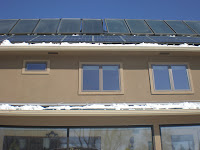
First of 5-part series profile/feature of Eric Doub, owner of green building company EcoFutures (by Molly)
Eric Doub’s net-zero-energy home
Daily, a futuristic-looking house in north Boulder devours energy bestowed by Colorado’s generous sunshine. Solar Harvest is the first net-zero-waste, energy-producing house in Boulder. Forty photovoltaic and solar thermal panels drape the roofs of the modern stucco landmark.
“It’s a laboratory for what we do, and we happen to be living in it,” said Eric Doub, general contractor, owner of Solar Harvest and of the green building firm EcoFutures. He designed the home with his wife Catherine and lives in it with third-grade son Brian and 11-year-old daughter Ariel.
Doub, 45, is about six feet tall with thick, smoke-colored hair and a focused blue gaze. He’s helped hundreds of houses exploit the sun’s free energy since founding EcoFutures in 1993. His mission is to build homes that create zero waste, and he approaches his job with an idealistic and innovative spirit that spills over into his personal life and influences his family, employees, clients and others in both the environmental and building industry. Doub judges the current sustainability movement, even his own progress in green building, as better than nothing but not nearly good enough. He wants to help society raise the bar, which is why he built Solar Harvest.
On a balmy Tuesday morning in late February, Doub led two prospective clients from Kansas and two curious onlookers on a room-by-room, two-hour tour of Solar Harvest. He couldn’t have been more comfortable leading strangers through his home. A transfixed listener and communicator, Doub is happy to venture onto ecological and philosophical tangents. He can also rattle off engineering quotients and mechanical data that make your head spin, which he directed mainly toward the mechanical engineer on the tour.
Since moving into the modern stucco home in 2005, Doub has led 2,600 prospective clients and solar buffs around to show off the geothermal ins and outs and luxurious accoutrements of the solar house.
“The novelty is still there after two-plus years. It’s been really cold this winter, and you come inside from outdoors, and it’s just toasty warm,” Doub said. “And you go, ‘Where is this heat coming from? Oh yeah, it was sunny two days ago and the house is still holding the heat.”
Visitors squinted as the sun melted recent snow off his solar panels. Energy monitors by the garage showed the house was generating 5,000 watts at that very moment. A microwave uses about 1,500 of those watts. A 6.4-kilowat photovoltaic array was mounted on the roof, its flat-plate panels containing cells made of silicon semiconductors. When sunlight hits the plates, the semiconductors collect energy and knock electrons loose to flow freely. An electric field in the panel forces the electrons to flow in one direction and an electrical direct current, or DC, is created. The DC is then passed through an inverter and is converted into the alternating current, AC, that powers Doub’s home.
The system, tied to the grid, sells extra energy to Xcel Energy on sunny days and buys energy on cloudy days. On a partly cloudy day in March, Solar Harvest generated about 21 kilowatt-hours (kWh,) consumed about 17 kWh and sold 4 kWh to the grid. Over the course of a year, net-zero homes produce as much or more energy than they consume.
No comments:
Post a Comment